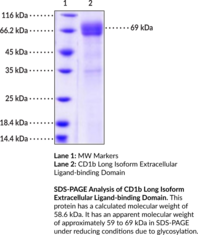Territorial Availability: Available through Bertin Technologies only in France
- Correlated keywords
- CD 1 B b trans membrane extra cellular ? 3 ? 2 micro globulin cyto endo plasmic AP TLR IL1? GMCSF sphingo phospho lipids lipo glycans post mortem IgG Ser 18 glyco protein
- Product Overview:
CD1b is a member of the CD1 family of transmembrane glycoproteins and is an MHC class I-like molecule that presents lipid antigens to T cells.{54129} Alternative splicing of CD1B produces one full-length isoform, CD1b long, and one short isoform.{54136} CD1b long exists as a tetramer where each monomer is composed of a transmembrane CD1 heavy chain that contains three extracellular domains (?1-?3), which associate with ?2-microglobulin to form a lipid-binding groove, as well as a cytoplasmic tail that contains a YXXZ endosomal sorting motif and interacts with the chaperone proteins AP-2 and AP-3 to direct CD1b intracellular trafficking.{54129,54136,54130,54131} The CD1b short isoform lacks the endosomal sorting motif and is confined to the cell surface.{54136} CD1b expression is induced in antigen-presenting cells by bacteria or toll-like receptor 2 (TLR2), IL-1?, or GM-CSF stimulation and functions to present a variety of lipid antigens to T cells.{54132} CD1b is synthesized in the endoplasmic reticulum and is transported to the cell membrane where it expresses self-lipids, such as sphingolipids and phospholipids.{54132,54133} It is then internalized and localizes to the late endosome or lysosome where it exchanges self-lipids for pathogen-derived lipids, including mycolates and lipoglycans, prior to being re-expressed on the cell surface for T cell presentation. CD1b protein levels are increased in skin lesions from patients with leprosy, in lung granulomas from patients with tuberculosis, and in postmortem-derived brain lesions from patients with multiple sclerosis.{54132,54135} CD1B SNPs have been found in patients with prostate cancer.{54134} Cayman’s CD1b Long Isoform Extracellular Ligand-binding Domain (human, recombinant) protein is a disulfide-linked homodimer. The reduced monomer, comprised of CD1b Long Isoform Extracellular Ligand-binding Domain (amino acids 18-303) fused to human IgG1 Fc at its C-terminus, consists of 527 amino acids, has a calculated molecular weight of 58.6 kDa, and a predicted N-terminus of Ser18. As a result of glycosylation, the monomer migrates at approximately 59 to 69 kDa by SDS-PAGE under reducing conditions.
Cayman Chemical’s mission is to help make research possible by supplying scientists worldwide with the basic research tools necessary for advancing human and animal health. Our utmost commitment to healthcare researchers is to offer the highest quality products with an affordable pricing policy.
Our scientists are experts in the synthesis, purification, and characterization of biochemicals ranging from small drug-like heterocycles to complex biolipids, fatty acids, and many others. We are also highly skilled in all aspects of assay and antibody development, protein expression, crystallization, and structure determination.
Over the past thirty years, Cayman developed a deep knowledge base in lipid biochemistry, including research involving the arachidonic acid cascade, inositol phosphates, and cannabinoids. This knowledge enabled the production of reagents of exceptional quality for cancer, oxidative injury, epigenetics, neuroscience, inflammation, metabolism, and many additional lines of research.
Our organic and analytical chemists specialize in the rapid development of manufacturing processes and analytical methods to carry out clinical and commercial GMP-API production. Pre-clinical drug discovery efforts are currently underway in the areas of bone restoration and repair, muscular dystrophy, oncology, and inflammation. A separate group of Ph.D.-level scientists are dedicated to offering Hit-to-Lead Discovery and Profiling Services for epigenetic targets. Our knowledgeable chemists can be contracted to perform complete sample analysis for analytes measured by the majority of our assays. We also offer a wide range of analytical services using LC-MS/MS, HPLC, GC, and many other techniques.
Accreditations
ISO/IEC 17025:2005
ISO Guide 34:2009
Cayman is a leader in the field of emerging drugs of abuse, providing high-purity Schedule I-V Controlled Substances to federally-licensed laboratories and qualified academic research institutions for forensic analyses. We are certified by ACLASS Accreditation Services with dual accreditation to ISO/IEC 17025:2005 and ISO Guide 34:2009.





